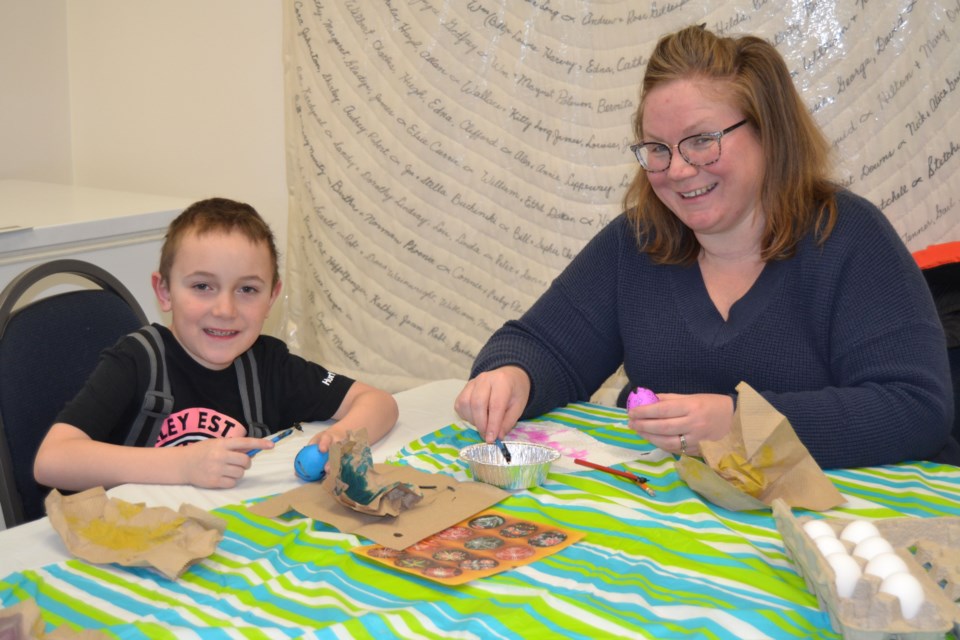PREECEVILLE - The art of Ukrainian Easter Egg decorating has become a passion and a tradition for many in the Preeceville and surrounding areas. Doreen Bochnuik and Sheila Ivanochko hosted a learn how to make pysanky (Ukrainian Easter eggs) in Preeceville on March 21 at the Preeceville Trinity United Church.
One egg could take many hours or days to create, depending on the intricacy of the design.
The history of pysanky is very interesting: colours, styles, designs, and symbols all have specific meanings to the different regions of Ukraine. The creation and the blessing of pysanky is an important part of the Ukrainian culture, according to Little Baba's Cookbook by Mary Petrowski.
In the Christian interpretation, the design signifies the 40-day Lenten period, the 40 days of Christ’s fasting, the 40 martyrs or the 40 birds hovering around the 40 martyrs.
The Ukrainian pysanka (plural: pysanky) was believed to possess enormous power, not only in the egg itself (which harboured the nucleus of life), but also in the symbolic designs and colours drawn on the egg in a specific manner, according to prescribed rituals. Pysanky were used for various social and religious occasions and were considered to be a talisman, a protection against evil, as well as harbingers of good.
In ancient times pysanky were decorated only by women and young girls. The eggs were chosen with great care – only fertilized eggs were used, from chickens that had laid eggs for the first time. The decorating process was carried out in secret, away from the eyes of strangers, lest someone cast an evil spell on the egg. In pagan times, pysanky were decorated in early spring; with the introduction of Christianity, this was done before Easter.
The symbolic ornamentation of the pysanka consists mainly of geometric motifs, with some animal and plant elements. The most important motif is the stylized symbol of the sun, which is represented as a broken cross, a swastika (an ancient Sanskrit symbol), a triangle, an eight-point rosette, or a star. Other popular motifs are endless lines, stylized flowers, leaves, the tree of life, and some animal figures such as horses, stags, and birds. The influence of Christianity introduced such elements as crosses, churches, and fish.
The most popular method of decorating pysanky is the wax-resist method, known as batik. A special instrument called a kistka or ryl'tse is used to "write" the design. (Pysanka comes from the verb pysaty, to write.) The dyes used to decorate pysanky also had a symbolic meaning. Red symbolized the sun, life, joy; yellow stood for wealth and fertility; green was the symbol of spring and plant life. In the not-too-distant past, artisans prepared their own dyes, using natural products such as the bark of oak or ash trees, twigs from sour apple trees, saffron or willow tree leaves. Today, chemical dyes are used.
It took a long time for the Ukrainian pysanka to develop and achieve perfection. Although contemporary artisans continue to employ ancient symbols and traditional colours on the egg, the pysanka is no longer considered to be a talisman, just a beautiful folk art object.
There are a few different tools and methods for decorating pysanky. The dye is very potent and if stored properly can be re-used year after year. You can change the brightness of your dye by adding a bit of vinegar into the jar. Kystkas come in different sizes- fine, medium and heavy. It’s handy to have at least one of each so that you can make varying designs. A fine point is used for making intricate designs where a heavy point is used for filling in areas on the egg.
To ensure that a pysanky lasts for many years, drain the yolk out of the egg and spray it with a spray varnish. However, many people don’t drain the yolk, they just let the egg dry.




